Automated Generation of Geometric FE Models for Timber Structures Using 3D Point Cloud Data
Abstract
1. Introduction
2. Methodology
2.1. Raw Data Processing
2.2. Component Segmentation
2.2.1. Point Cloud Segmentation
2.2.2. Point Cloud Classification
2.2.3. Component Contact Relationship Determination
2.3. Geometric Information Extraction
2.3.1. Cylinder
- (i)
- Randomly select two points and solve for the line parameters they define.
- (ii)
- Calculate the distance from the remaining points to the line equation, and compare this distance with a preset threshold δ. If the distance is smaller than δ, classify the point as an inlier; otherwise, classify it as an outlier. Then, count the number of inliers.
- (iii)
- Repeat steps (i) and (ii). If the number of inliers for the current model exceeds the previously recorded maximum number of inliers, update the model parameters, retaining the model with the highest number of inliers.
- (iv)
- Iterate steps (i) to (iii) until the preset iteration threshold k is reached, finding the model parameters with the most inliers. Finally, use these inliers to re-estimate the model parameters and obtain the final model parameters.
- (v)
- Remove the inliers found from the original point cloud to form a new point cloud.
- (vi)
- Repeat steps (i) to (v) on the new point cloud until all lines are identified, as shown in Figure 5.
2.3.2. Hexahedron
2.4. Automatic Generation of Geometric Finite Element Model
3. Experiments and Discussion
3.1. Verification of Geometric Model
3.2. Analysis of FE Model
4. Conclusions
Author Contributions
Funding
Data Availability Statement
Conflicts of Interest
References
- Chen, J.; Xiong, H.; Wang, Z.; Liu, Y. Experimental buckling performance of eucalyptus-based oriented oblique laminated strand lumber columns under centric and eccentric compression. Constr. Build. Mater. 2020, 262, 120072. [Google Scholar] [CrossRef]
- Cao, J.; Xiong, H.; Chen, L. Procedure for parameter identification and mechanical properties assessment of CLT connections. Eng. Struct. 2019, 203, 109867. [Google Scholar] [CrossRef]
- Yuan, C.; Zhang, J.; Chen, L.; Xu, J.; Kong, Q. Timber moisture detection using wavelet packet decomposition and convolutional neural network. Smart Mater. Struct. 2021, 30, 035022. [Google Scholar] [CrossRef]
- Di Re, P.; Lofrano, E.; Ciambella, J.; Romeo, F. Structural analysis and health monitoring of twentieth-century cultural heritage: The Flaminio Stadium in Rome. Smart Struct. Syst. 2021, 2, 27. [Google Scholar]
- Andrea, U.; Alessandro, G.; Francesca, M.; Marco, Z. From scan-to-BIM to a structural finite elements model of built heritage for dynamic simulation. Autom. Constr. 2022, 142, 104518. [Google Scholar]
- Ventura, C.; Brincker, R.; Dascotte, E.; Andersen, P. FEM updating of the heritage court building structure. In Proceedings of the IMAC 19: A Conference on Structural Dynamics, Kissimmee, FL, USA, 5–8 February 2001. [Google Scholar]
- Lord, J.-F.; Ventura, C.E.; Dascotte, E. Automated model updating using ambient vibration data from a 48-storey building in Vancouver. In Proceedings of the 22nd International Modal Analysis Conference, Detroit, MI, USA, 26–29 January 2004. [Google Scholar]
- Lord, J.-F.; Ventura, C.E.; Dascotte, E.; Brincker, R. FEM updating using ambient vibration data from a 48-storey building in Vancouver, British Columbia, Canada. In Inter Noise & Noise Con Congress & Conference Proceedings, Proceedings of the 32nd International Congress and Exposition on Noise Control Engineering, Seogwipo, Republic of Korea, 25–28 August 2003; Institute of Noise Control Engineering: Washington, DC, USA, 2003. [Google Scholar]
- Steiner, B.; Mousavian, E.; Saradj, F.M.; Wimmer, M.; Musialski, P. Integrated structural–architectural design for interactive planning. In Computer Graphics Forum; Wiley Online Library: Hoboken, NJ, USA, 2017; Volume 36, pp. 80–94. [Google Scholar]
- Boonstra, S.; Blom, K.V.; Hofmeyer, H.; Emmerich, M.T. Hybridization of an evolutionary algorithm and simulations of co-evolutionary design processes for early-stage building spatial design optimization. Autom. Constr. 2021, 124, 103522. [Google Scholar] [CrossRef]
- Boonstra, S.; Blom, K.V.; Hofmeyer, H.; Emmerich, M.T.; Schijndel, J.; Wilde, P. Toolbox for super-structured and super-structure free multi-disciplinary building spatial design optimisation. Adv. Eng. Inform. 2018, 36, 86–100. [Google Scholar] [CrossRef]
- Bouzas, Ó.; Cabaleiro, M.; Conde, B.; Cruz, Y.; Riveiro, B. Structural health control of historical steel structures using HBIM. Autom. Constr. 2022, 140, 104308. [Google Scholar] [CrossRef]
- Mol, A.; Cabaleiro, M.; Sousa, H.S.; Branco, J. HBIM for storing life-cycle data regarding decay and damage in existing timber structures. Autom. Constr. 2020, 117, 103262. [Google Scholar] [CrossRef]
- Yang, L.; Cheng, J.C.; Wang, Q. Semi-automated generation of parametric BIM for steel structures based on terrestrial laser scanning data. Autom. Constr. 2020, 112, 103037. [Google Scholar] [CrossRef]
- Romero-Jarén, R.; Arranz, J.J. Automatic segmentation and classification of BIM elements from point clouds. Autom. Constr. 2021, 124, 103576. [Google Scholar] [CrossRef]
- Zhang, C.; Shu, J.; Shao, Y.; Zhao, W. Automated generation of FE models of cracked RC beams based on 3D point clouds and 2D images. J. Civ. Struct. Health Monit. 2022, 12, 29–46. [Google Scholar] [CrossRef]
- Che, E.; Jung, J.; Olsen, M.J. Object recognition, segmentation, and classification of mobile laser scanning point clouds: A state of the art review. Sensors 2019, 19, 810. [Google Scholar] [CrossRef] [PubMed]
- Lu, R.; Brilakis, I. Detection of structural components in point clouds of existing RC bridges. Comput.-Aided Civ. Infrastruct. Eng. 2019, 34, 191–212. [Google Scholar] [CrossRef]
- Hamid-Lakzaeian, F. Point cloud segmentation and classification of structural elements in multi-planar masonry building facades. Autom. Constr. 2020, 118, 103232. [Google Scholar] [CrossRef]
- Qi, C.R.; Su, H.; Mo, K.; Leonidas, J. Pointnet: Deep learning on point sets for 3d classification and segmentation. In Proceedings of the IEEE Conference on Computer Vision and Pattern Recognition, Honolulu, HI, USA, 21–26 July 2017. [Google Scholar]
- Qi, C.R.; Yi, L.; Su, H.; Leonidas, J. Pointnet++: Deep hierarchical feature learning on point sets in a metric space. In Proceedings of the Advances in Neural Information Processing Systems, Long Beach, CA, USA, 4–9 December 2017. [Google Scholar]
- Li, Y.; Bu, R.; Sun, M.; Wu, W.; Di, X.; Chen, B. Pointcnn: Convolution on x-transformed points. In Proceedings of the Advances in Neural Information Processing Systems, Montréal, QC, Canada, 3–8 December 2018. [Google Scholar]
- Lee, J.S.; Park, J.; Ryu, Y.M. Semantic segmentation of bridge components based on hierarchical point cloud model. Autom. Constr. 2021, 130, 103847. [Google Scholar] [CrossRef]
- Kim, H.; Yoon, J.; Sim, S.H. Automated bridge component recognition from point clouds using deep learning. Struct. Control Health Monit. 2020, 27, e2591. [Google Scholar] [CrossRef]
- Arayici, Y. Towards building information modelling for existing structures. Struct. Surv. 2008, 26, 210–222. [Google Scholar] [CrossRef]
- Pătrăucean, V.; Armeni, I.; Nahangi, M.; Yeung, J.; Brilakis, I.; Haas, C. State of research in automatic as-built modelling. Adv. Eng. Inform. 2015, 29, 162–171. [Google Scholar] [CrossRef]
- Arias, P.; Armesto, J.; Lorenzo, H.; Ordóñez, C. Digital photogrammetry, GPR and finite elements in heritage documentation: Geometry and structural damages. In Proceedings of the ISPRS Commission V Symposium: Image Engineering and Vision Metrology, Dresden, Germany, 25–27 September 2006. [Google Scholar]
- Lu, R.; Brilakis, I. Digital twinning of existing reinforced concrete bridges from labelled point clusters. Autom. Constr. 2019, 105, 102837. [Google Scholar] [CrossRef]
- Kassotakis, N.; Sarhosis, V.; Mills, J.; Antonio, M. From point clouds to geometry generation for the detailed micro-modelling of masonry structures. In Proceedings of the 10th International Masonry Conference, Milan, Italy, 9–11 July 2018. [Google Scholar]
- Barazzetti, L.; Banfi, F.; Brumana, R.; Gusmeroli, G.; Previtali, M.; Schiantarelli, G. Cloud-to-BIM-to-FEM: Structural simulation with accurate historic BIM from laser scans. Simul. Model. Pract. Theory 2015, 57, 71–87. [Google Scholar] [CrossRef]
- Jiang, S.; Yang, Y.; Gu, S.; Li, J.; Hou, Y. Bridge Geometric Shape Measurement Using LiDAR–Camera Fusion Mapping and Learning-Based Segmentation Method. Buildings 2025, 15, 1458. [Google Scholar] [CrossRef]
- Wang, D.; Liu, J.; Jiang, H.; Liu, P.; Jiang, Q. Existing Buildings Recognition and BIM Generation Based on Multi-Plane Segmentation and Deep Learning. Buildings 2025, 15, 691. [Google Scholar] [CrossRef]
- Patil, J.; Mohsen, K. Automatic Scan-to-BIM—The Impact of Semantic Segmentation Accuracy. Buildings 2025, 15, 1126. [Google Scholar] [CrossRef]
- Proença, P.F.; Gao, Y. Fast cylinder and plane extraction from depth cameras for visual odometry. In Proceedings of the 2018 IEEE/RSJ International Conference on Intelligent Robots and Systems (IROS), Madrid, Spain, 1–5 October 2018. [Google Scholar]
- Mathew, V.; Amin, R. Optimizing Fast-Paced Sacn-to-BIM Projects Using ReCap, Revit, Navisworks. Available online: https://www.autodesk.com/autodesk-university/class/Optimizing-Fast-Paced-Scan-BIM-Projects-Using-ReCap-Revit-Navisworks-2018 (accessed on 4 February 2019).
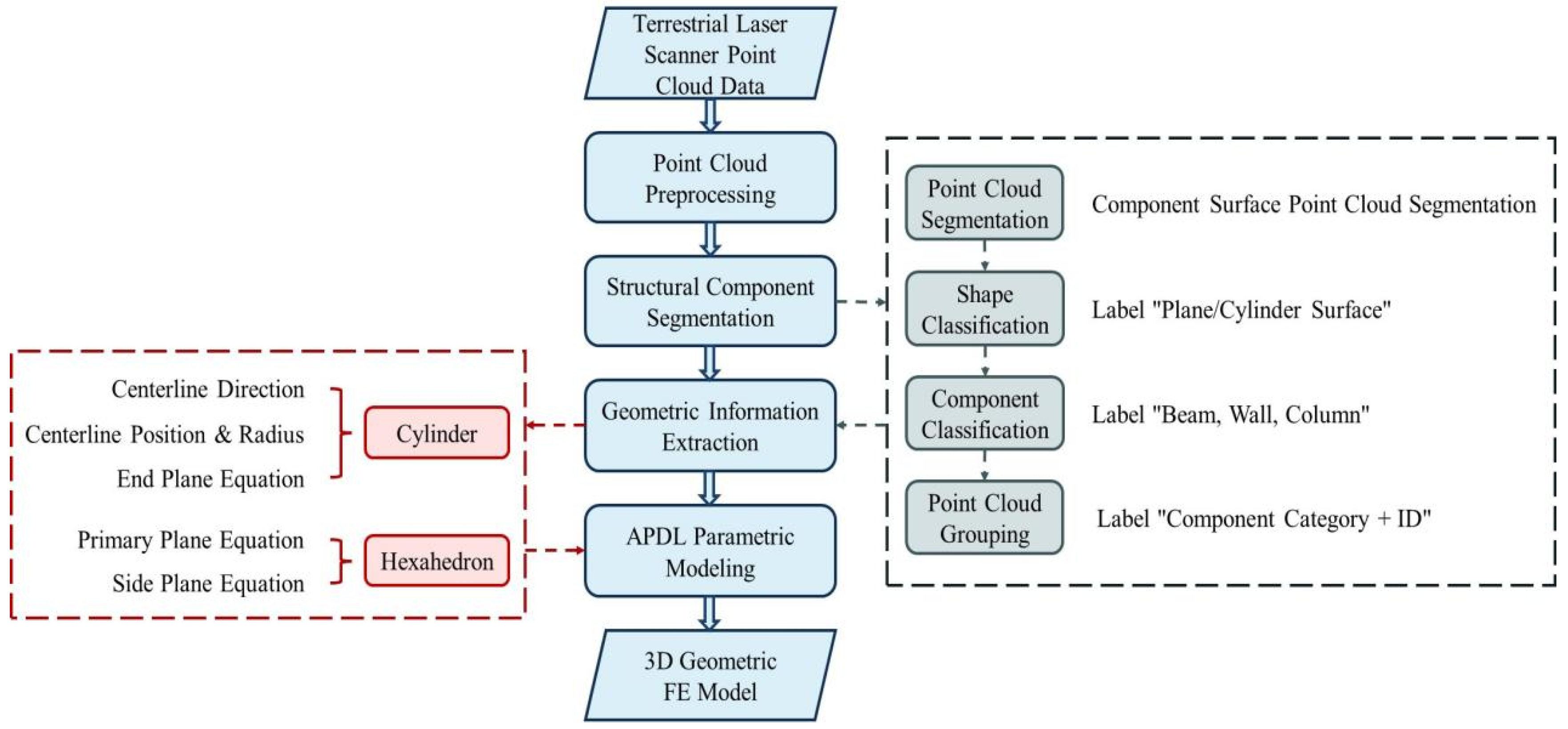

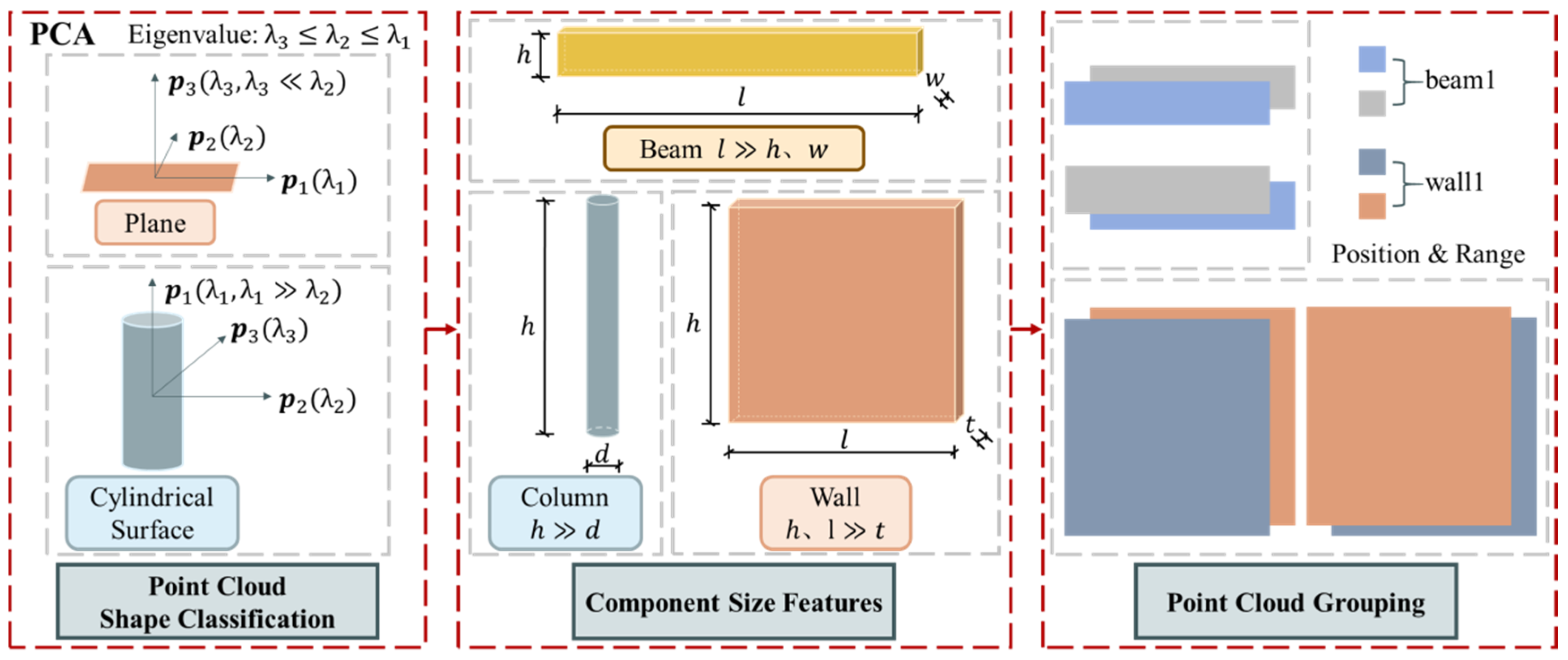

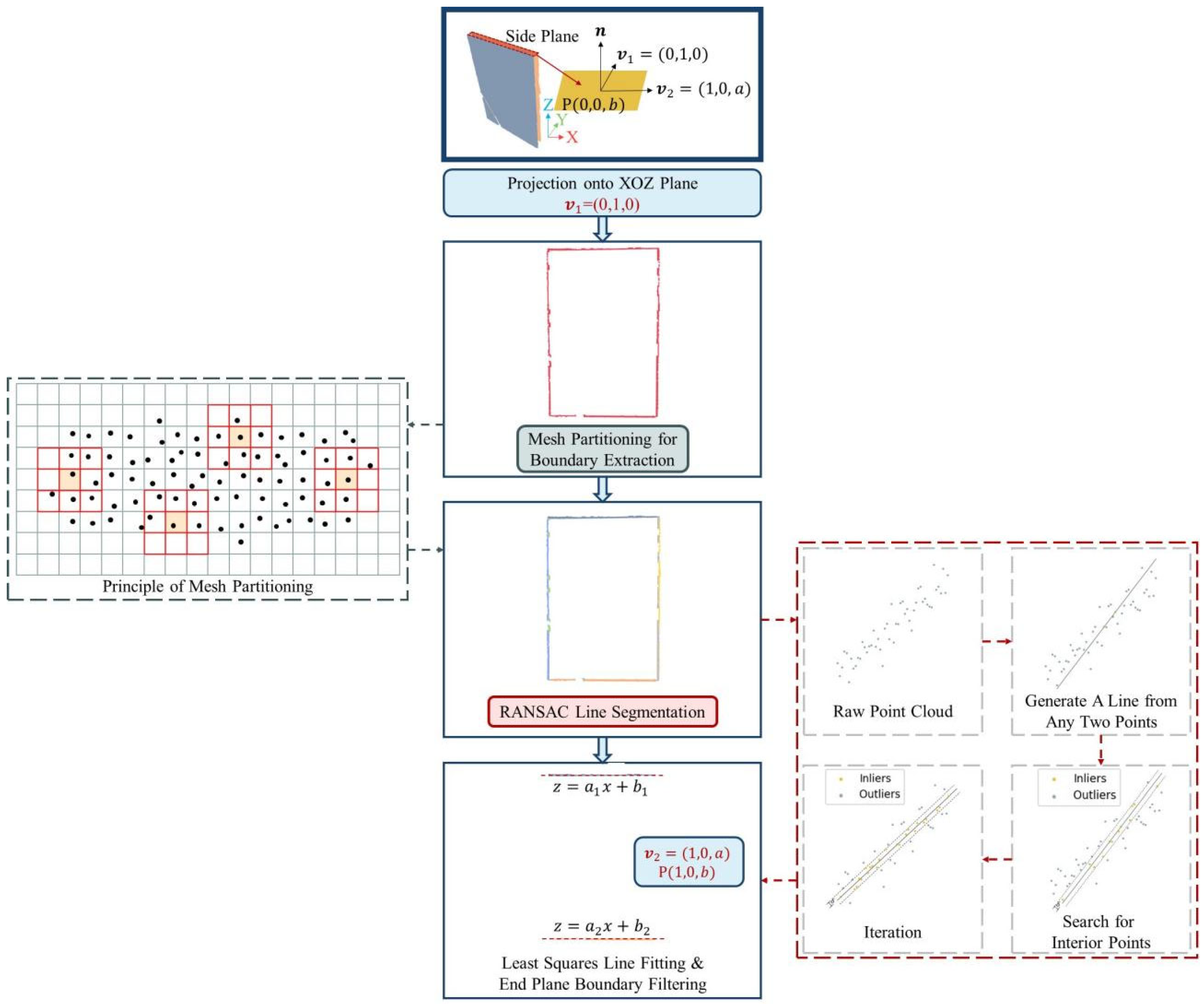

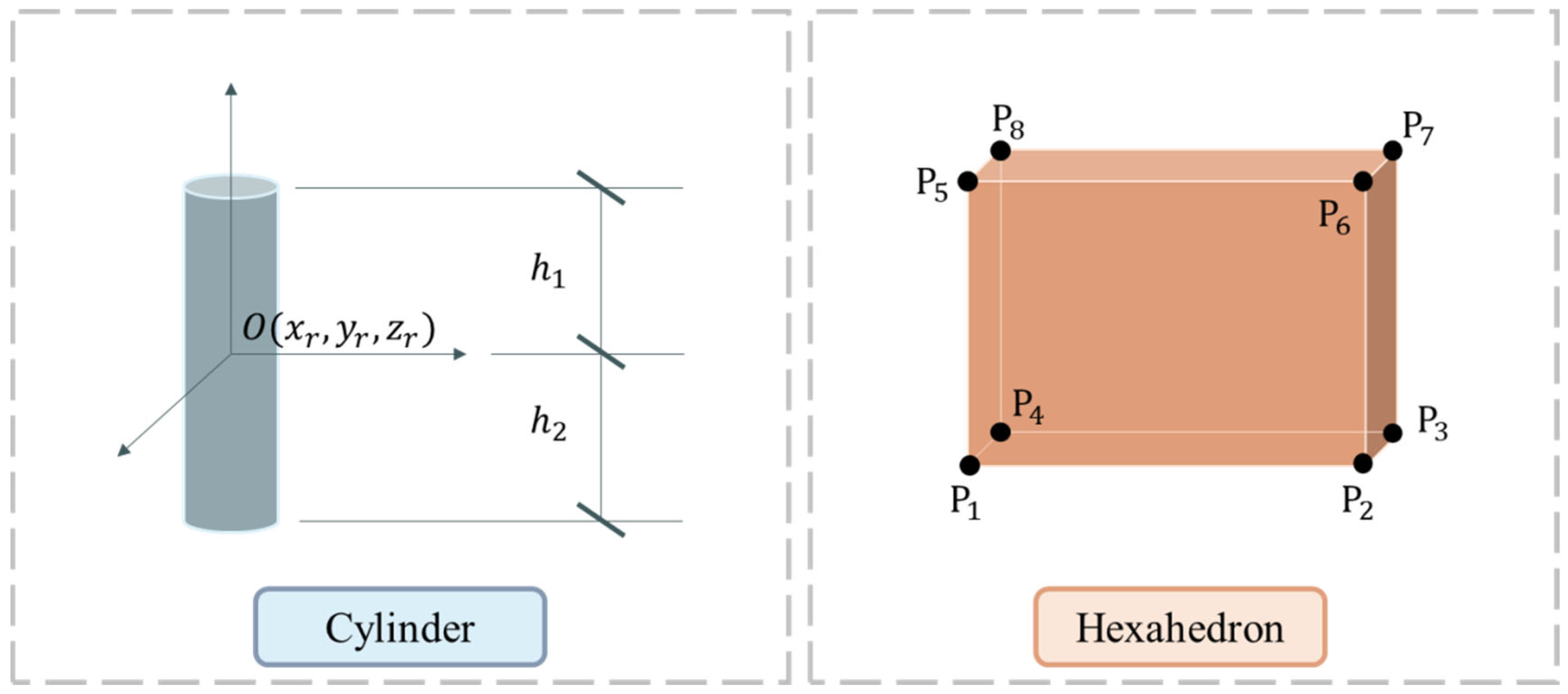

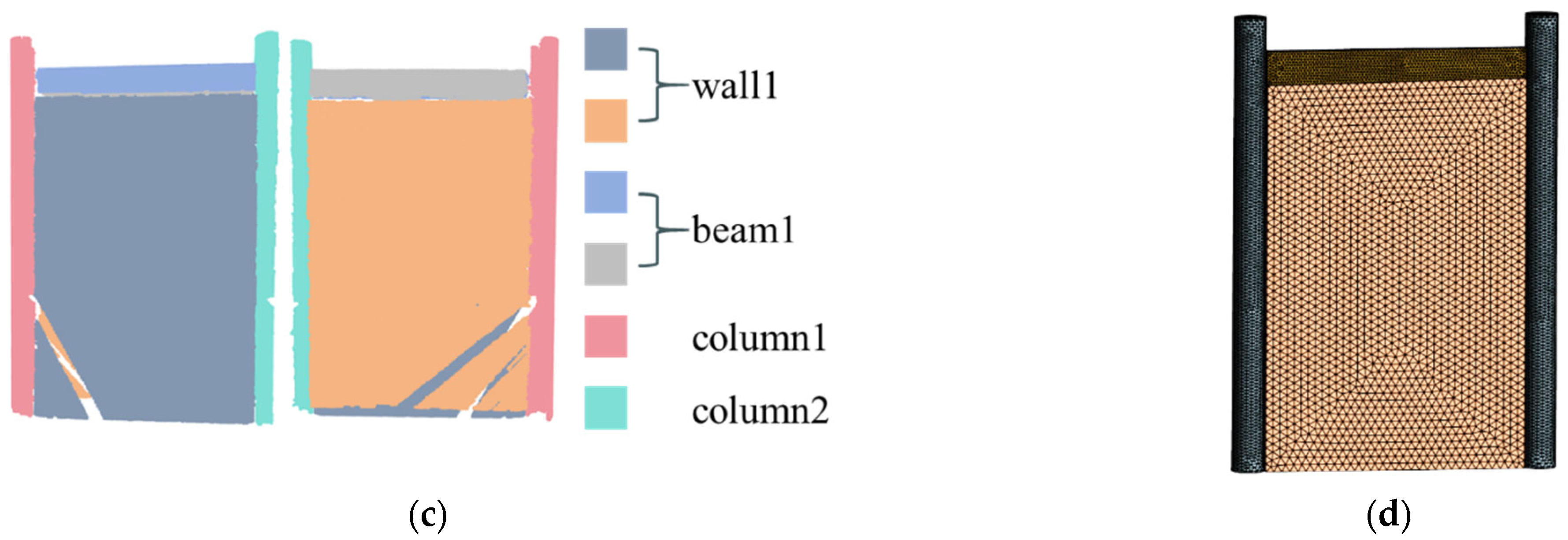


| Research | Year | Structural Type | Modeling Method | Output Format | Efficiency |
|---|---|---|---|---|---|
| Arayici [25] | 2008 | Steel bridge | Manually using software + coding | BIM in Revit | Medium |
| Yang [14] | 2020 | Masonry | Manually using software | BIM in IFC format | Slow |
| Mol [13] | 2020 | Timber roof | Manually using software | BIM in Revit | Slow |
| Remero [15] | 2021 | RC column | Algorithm processing + manual modeling | BIM in IFC format | Medium |
| Bouzas [12] | 2022 | Steel bridge | Manually using software + drawings assistant | BIM in IFC format | Slow |
| Zhang [16] | 2022 | RC beam with cracks | Algorithm processing on images and cloud points + drawings assistant | Damaged FEM | Medium |
| Algorithm Objective | Algorithm | Parameters | |
|---|---|---|---|
| Point cloud segmentation | Region growing | Smoothing threshold | Curvature threshold |
| 6° | 0.01 | ||
| Geometry information extraction | RANSAC | Distance threshold for plane fitting | Distance threshold for line fitting |
| 0.003 m | 0.015 m | ||
| Boundary extraction | Mesh partition | Grid size | |
| 0.02 m | |||
| Component | Dimension | Actual Value (m) | Identified Value (m) | Absolute Error (m) | Relative Error (%) |
|---|---|---|---|---|---|
| Beam 1 | Length | 1.600 | 1.598 | −0.002 | 0.13 |
| Width | 0.080 | 0.080 | 0.000 | 0.00 | |
| Height | 0.200 | 0.197 | −0.003 | 1.50 | |
| Wall 1 | Length | 1.600 | 1.598 | −0.002 | 0.13 |
| Width | 0.120 | 0.117 | −0.003 | 2.50 | |
| Height | 2.400 | 2.374 | −0.026 | 1.08 | |
| Column 1 | Radius | 0.100 | 0.102 | 0.002 | 2.00 |
| Height | 2.800 | 2.777 | −0.023 | 0.82 | |
| Column 2 | Radius | 0.100 | 0.100 | 0.000 | 0.00 |
| Height | 2.800 | 2.783 | −0.017 | 0.61 |
| Component | Plane | Normal Direction | Angle with XOY (°) | Angle with YOZ (°) | Angle with XOZ (°) |
|---|---|---|---|---|---|
| Beam 1 | Principal Plane 1 | (−0.000, −1.000, −0.015) | 90.86 (0.86) | 90.00 (0.00) | 0.00 |
| Principal Plane 2 | (−0.000, 1.000, −0.003) | 90.17 (0.17) | 90.00 (0.00) | 0.00 | |
| Top Plane | (−0.000, 0.000, 1.000) | 0.00 | 90.00 (0.00) | - | |
| Bottom Plane | (−0.015, 0.000, 1.000) | 0.00 | 90.86 (0.86) | - | |
| Wall 1 | Principal Plane 1 | (0.002, −1.000, 0.005) | 89.71 (−0.29) | 89.88 (−0.12) | 0.00 |
| Principal Plane 2 | (−0.001, 1.000, −0.002) | 90.11 (0.11) | 90.06 (0.06) | 0.00 | |
| Top Plane | (−0.015, 0.000, 1.000) | 0.00 | 90.86 (0.86) | - | |
| Bottom Plane | (0.001, −0.000, 1.000) | 0.00 | 89.94 (−0.06) | - | |
| Column 1 | Top Plane | (0.004, −0.000, 1.000) | 0.00 | 89.77 (−0.23) | - |
| Bottom Plane | (0.001, −0.000, 1.000) | 0.00 | 89.94 (−0.06) | - | |
| Column 2 | Top Plane | (0.004, −0.000, 1.000) | 0.00 | 89.77 (−0.23) | - |
| Bottom Plane | (0.001, −0.000, 1.000) | 0.00 | 89.94 (−0.06) | - |
| Material | |||||||||
|---|---|---|---|---|---|---|---|---|---|
| Wood | |||||||||
| 12,036 | 451 | 451 | 0.35 | 0.38 | 0.05 | 600 | 600 | 60 | |
| Masonry | Poisson’s ratio | ||||||||
| 2400 | 0.20 | ||||||||
| Contact Area | Contact Relationship |
|---|---|
| Between timber column and timber beam | Friction type |
| Between masonry wall and wooden frame | Friction type |
| Between the timber column and the ground | Friction type |
| Between the masonry wall and the ground | Tie type |
Disclaimer/Publisher’s Note: The statements, opinions and data contained in all publications are solely those of the individual author(s) and contributor(s) and not of MDPI and/or the editor(s). MDPI and/or the editor(s) disclaim responsibility for any injury to people or property resulting from any ideas, methods, instructions or products referred to in the content. |
© 2025 by the authors. Licensee MDPI, Basel, Switzerland. This article is an open access article distributed under the terms and conditions of the Creative Commons Attribution (CC BY) license (https://creativecommons.org/licenses/by/4.0/).
Share and Cite
Chen, L.; Jiang, L.; Xiong, H. Automated Generation of Geometric FE Models for Timber Structures Using 3D Point Cloud Data. Buildings 2025, 15, 2213. https://doi.org/10.3390/buildings15132213
Chen L, Jiang L, Xiong H. Automated Generation of Geometric FE Models for Timber Structures Using 3D Point Cloud Data. Buildings. 2025; 15(13):2213. https://doi.org/10.3390/buildings15132213
Chicago/Turabian StyleChen, Lin, Liufang Jiang, and Haibei Xiong. 2025. "Automated Generation of Geometric FE Models for Timber Structures Using 3D Point Cloud Data" Buildings 15, no. 13: 2213. https://doi.org/10.3390/buildings15132213
APA StyleChen, L., Jiang, L., & Xiong, H. (2025). Automated Generation of Geometric FE Models for Timber Structures Using 3D Point Cloud Data. Buildings, 15(13), 2213. https://doi.org/10.3390/buildings15132213





